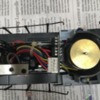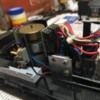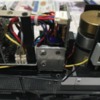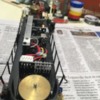gunrunnerjohn posted:It certainly is a huge improvement, if you're running multiple locomotives, having cruise makes all the difference in the world.
I'm confused about the width being an issue, the board is the same width as the DCDR it replaces.
The length is where the usual fit issues arise. Another issue is the connector placement, and the extra 10-pin connector. Finally,there's the large bridge sticking up in the middle, that is frequently where the wires were routed for the DCDR. I know in the Camelback, the connector positions dictated a lot of screwing around to get the CC-M in. I actually had to remove a connector from the motherboard for clearance and hard wire some stuff
Morning Gunrunnerjohn,
Appreciate the further insight! I did some measurements last night of my existing DCDR board and the dimensions appear to be right in line with the dimensions of the CC M board per ERR’s website. ERR lists the CC M as being 1.95" L x 1.27" W x 1.0" H. I have attached some pics of my existing DCDR in my SD-35 so you can take a look at them and let me know if you think mine looks like a routine easy replacement or a PITA... ; )
I was hoping there was a screw on the bottom of the chassis (none that I can see) that holds the heat sink in place so I could remove the entire heat sink / DCDR board together. I know I can remove the DCDR board by removing the two screws on each side of the heat sink, but it looks as if it will be next to impossible to put the two bottom nuts back in place when I go to install the new CC M and try to put the bottom screws in place that will attach the heat sink to the new CC M.
It appears that my existing DCDR only has a 4 pin motor phase/direction input and the 4 pin Molex connector with no serial input from the R2LC. This is the other challenge as I will have to figure out how my old DCDR received the serial input from the R2LC as I know the serial input from the R2LC on the new CC M has to go to the connector 1 on the new 10 pin connector.
I believe the investment will definitely be worth it as the existing performance at low speeds is much to be desired relative to my newer engines that creep around the board at a constant speed.









